|
 Cheimonophyllum candidissimum Cheimonophyllum candidissimum
SynonymsAgaricus candidissimus
Pleurotus candidissimus
BiostatusPresent in region - Indigenous. Non endemic
Images (click to enlarge)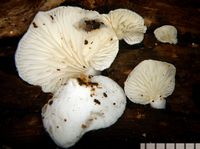
Owner: J.A. Cooper | 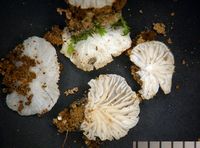
Owner: J.A. Cooper | 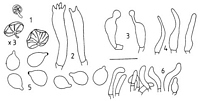
Caption: 1, Basidiomes x3; 2, basidia; 3, pseudobasidia; 4, awl-shaped cells; 5, spores; 6, pileipellis (1, 2, 4, 6 PDD 60840; 3, 5 PDD 60839). Magnifications: basidiome (natural size unless stated otherwise), bar = 20 mm; basidia, cystidia, pileipellis elements x | 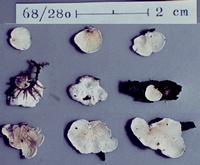
Caption: ZT68-280
Owner: E. Horak: © Creative Commons Attribution-Noncommercial 3.0 New Zealand | 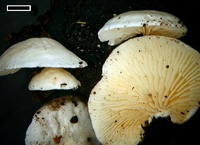
Caption: scale=2mm.
Owner: J.A. Cooper | 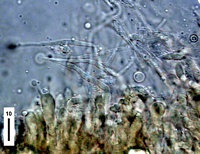
Caption: basidia and cheilocystidia
Owner: J.A. Cooper | 
Caption: spores and cap hyphae with crystals
Owner: J.A. Cooper | 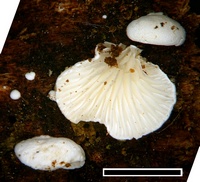
Caption: scale=5mm
Owner: J.A. Cooper | 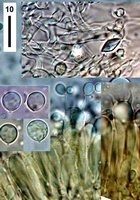
Owner: J.A. Cooper | 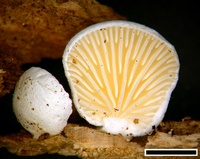
Owner: J.A. Cooper | 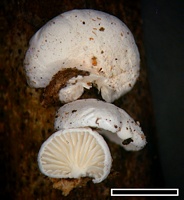
Owner: J.A. Cooper | 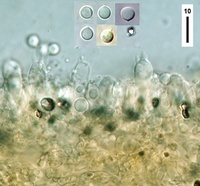
Owner: J.A. Cooper | 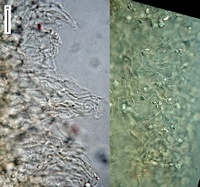
Caption: left: cheilocystidia. Right: cap hyphae.
Owner: J.A. Cooper | 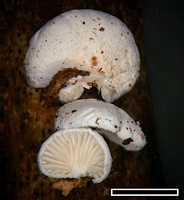
Caption: FUNNZ2007/0590
Owner: FUNNZ |
Article: Segedin, B.P. (1994). Studies in the Agaricales of New Zealand: new records and new species of the genera Cheimonophyllum, Mniopetalum, and Anthracophyllum (Tricholomataceae, Collybieae). New Zealand Journal of Botany 32: 61-72 (http://www.rsnz.org/publish/abstracts.php).
Description: Basidiome 3-5 mm diam., pure white, drying pale yellow brown, translucent when moist, fan-shaped to reniform, convex, sessile, attached dorsally or excentrically to the substratum by a subiculum of white hyphae, or sometimes laterally stipitate, or occasionally almost centrally stipitate when young. Pileus surface white, velutinous to villose, margin inrolled at first, then even to sometimes lobed. Lamellae white, 1-2 series, up to 8 principal ones, moderately distant and fairly broad, with occasional interveining. Stipe (when present) 1-2 x 0.5-1 mm, white and translucent when fresh, pubescent when dry. Smell and taste unknown. Spore print cream.
Spores 4.7 6.5 x 4-5.5 (5.2 x 4.8) µm, Q = 1.08, sub spherical to broadly pyriform, very thin walled, smooth, hyaline; inamyloid, not dextrinoid, acyanophilic, contents granular, apiculus cylindrical and very distinct, or slightly conical in pyriform spores, often with a dark, subterminal scar. Basidia 15-30 x 5.5 µm, cylindric to clavate, 1-2-4-spored, sterigmata variable in length, 2.5-6 µm; some basidia-like structures also present, with 1 or 2 apical, capitate processes slightly resembling saccate sterigmata and spores (pseudobasidia). Pleurocystidia and cheilocystidia none but occasional awl-shaped cells with pointed ends were seen extending from the hymenium. Trama has a faintly differentiated central strand of somewhat parallel hyphae, (5 µm diam., giving a bilateral appearance; lateral hyphae more loosely interwoven and merging into the filamentous subhymenium; a few oleiferous hyphae present in the trama. Context of interwoven hyphae 4 5 µm diam., some inflated to 9 µm. Pileipellis trichodermal, of erect hyphal endings from the context, sometimes in clumps of 3 or 4. Stipe cortex of narrow, somewhat thick-walled hyphae with some scattered, short, narrow, simple protuberances (10-15 x 1-1.5 µm). All hyphae with clamp-connections.
Habitat: On mossy bark of dead wood in mixed podocarp broadleaf forest.
Notes: This fungus resembles the descriptions of Singer (1964) and others with one or two differences. The basidia were 1 -, 2- or 4- spored rather than 4-spored only and, although awl-shaped cheilocystidia were seen, they did not form a distinct layer as described by Horak (1968) and Pegler (1983). The presence of cheilocystidia in this genus is controversial. Dennis (1953) did not report them in the type of C. candidissimum, nor in Pleurotus subhaedinus (Murrill) Murrill and P. subelatinus (Murrill) Murrill, now considered as synonyms of C. candidissimum. Pleurotus dictyorhizas, possibly also a Cheimonophyllum species, was also described by Josserand (1955) as having awl-shaped cheilocystidia, "rather numerous". Singer (1964) found what he called cheilocystidia in C. candidissimum "on or near the heteromorphous or sub heteromorphous edge intermixed with basidia", but he later (Singer 1969) described them as "modified tramal hyphae". In support of this view, Reijnders & Stalpers ( 1992), in their study of tramal types in the Aphyllophorales and Agaricales, have shown that in C. candidissimum the development of the hymenophoral trama is trametoid, that is, "a conspicuous tuft of loosely interwoven, sterile hyphae is present on the edge of the young gill", and they claim that the filamentous, somewhat branched cheilocystidia mentioned by earlier workers are sterile hyphae of the trama. Similar structures have also been found, although only in the vicinity of the margin of the pileus, in mature basidiomes of C. roseum (see below).
|